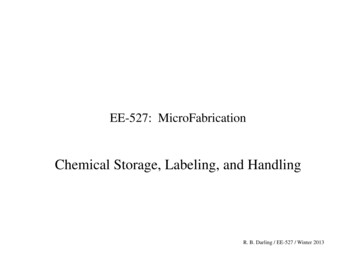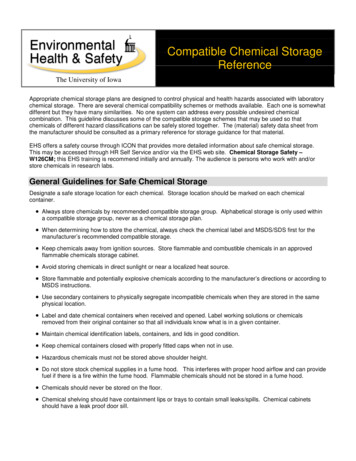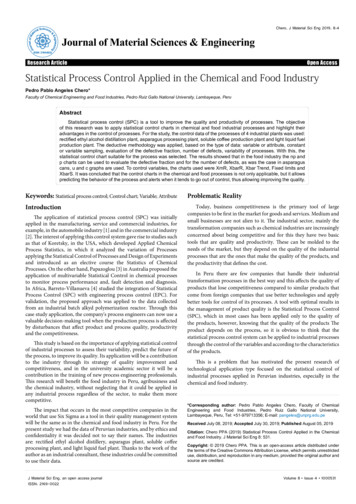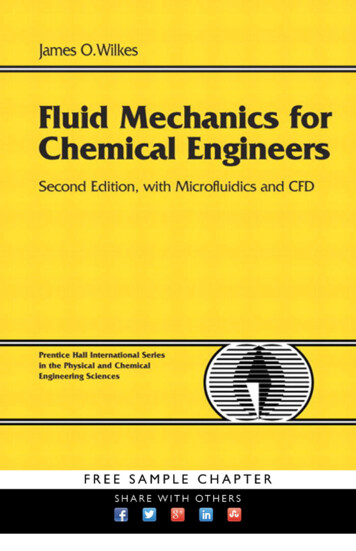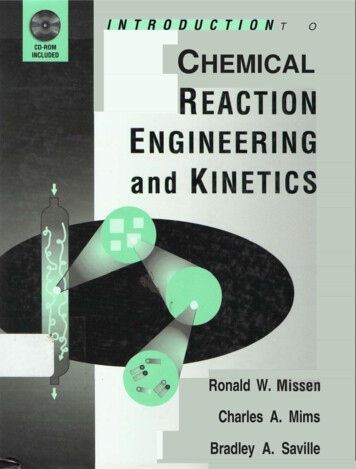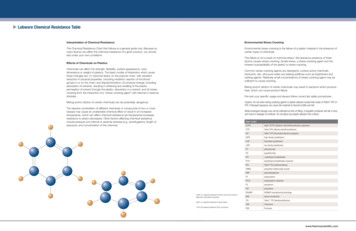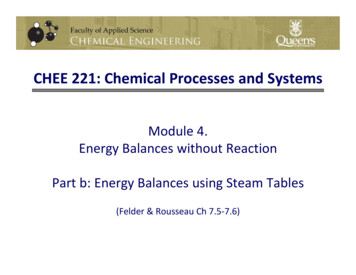
Transcription
CHEE 221: Chemical Processes and SystemsModule 4.Energy Balances without ReactionPart b: Energy Balances using Steam Tables(Felder & Rousseau Ch 7.5‐7.6)
Energy Balances:Accumulation In – Out EK EP U Q WContinuous (Open) System at Steady‐State: E E H Q W Batch (Closed) System:KPs Changes in kinetic and potential energy can becalculated (usually small for chemical systems) Heat and work input is given in the problem (or isoften what you must solve for) The major task is calculating changes in U or H– Ch 7: Using tabulated values (steam tables)– Ch 8: Calculate as function of phase and T– Ch 9: Energy balances with Rxn
Thermodynamic DataIt is not possible to know the absolute value of Û or Ĥ for a pure substance,but you can determine the change in Uˆ ( Uˆ ) or Hˆ ( Hˆ ) corresponding to aspecified change of state (temperature, pressure, and phase). The change isactually often what we want to know.A common practice is to arbitrarily designate a reference state for a substanceat which Û and Ĥ are arbitrarily set to be equal to zero, and then tabulate Ûand/or Ĥ for the substance relative to the reference state. For example,CO (g, 0 C, 1 atm) CO (g,100 C, 1 atm):reference state Hˆ CO Hˆ CO 0 2919 J/molWe say: “The specific enthalpy of CO at 100 C and 1 atm relative to CO at 0 Cand 1 atm is 2919 J/mol”.CHEE 221F&R Ch 7.5a3
Reference States and State Properties Most (all?) enthalpy tables report the reference states (T, P and State) onwhich the values of Ĥ are based; however, it is not necessary to know thereference state to calculate H (change in enthalpy) for the transitionfrom one state to another.– H from state 1 to state 2 equals Hˆ 2 Hˆ 1 regardless of the referencestate upon which Ĥ 1 and Ĥ 2 were based– Caution: If you use different tables, you must make sure they have thesame reference state This result is a consequence of the fact that Ĥ (and Û ) are stateproperties, that is, their values depend only on the state of the species(temperature, pressure, state) and not on how the species reached itsstate.When a species passes from one state to another, both Û and Ĥ forthe process are independent of the path taken from the first state to thesecond one.CHEE 221F&R Ch 7.5a4
F&R Example 7.5‐1The following entries are taken from a data table for saturated methyl chloride:P (psia)Vˆ (ft 3 /lb m )StateT( 20202.286.878Ĥ (Btu/lb m )0.015530.0001. What reference state was used to generate the given enthalpies?2. Calculate Ĥ and Û for the transition of saturated methyl chloridevapour from 50 F to 0 F.CHEE 221F&R Ch 7.5a5
Steam TablesTables located in the back of F&R can be used to estimate Û , Ĥ ,and Vˆ for liquid water and steam (water vapour) at any specifiedtemperature and pressure.Recall the phase diagram for water:Subcooled liquidVapour‐liquidequilibrium (VLE)curve or saturationline – water may existas saturated water,saturated steam(vapour) or mixture ofboth.superheated steamCHEE 221F&R Ch 7.5b6
Steam TablesSaturated Steam Tables: Data taken along the VLE curve or saturation line. Table B.5 Saturated Steam: Properties of saturated water and saturatedsteam as a function of temperature from 0.01 C (triple point) to 102 C. Noteboiling points at various P values and vapour pressures at T values. Table B.6 Saturated Steam: Properties of saturated water and saturatedsteam as a function of pressure (same data as Table B.5 but over a muchlarger range of temperatures and pressures).Superheated Steam Table: Data taken from points below the VLE curve orsaturation line – vapour heated above its saturation temperature. Table B.7 Superheated Steam: Properties of superheated steam at anytemperature and pressure – includes data for liquid water (data in theenclosed region), and saturated water and saturated steam.CHEE 221F&R Ch 7.5a7
Notes on the Steam Tables Reference state for the tabulated thermodynamic data in the steam tablesis liquid water at the triple point (0.01 C and 0.00611 bar) [triple point iswhere all three phases of water can coexist]kJkJˆU andHˆ kgkg Heat of vapourization (evaporation) is the difference between vapour andliquid enthalpies Units are on a mass basis: Properties of liquid water are not a strong function of pressure at constanttemperature, therefore Ĥ Û since volume change is small Volumetric properties of steam are extensively tabulated: when steamtables are available, don’t use the ideal gas law. Remember:CHEE 221Hˆ ( P, T ) Uˆ PVˆF&R Ch 7.5a8
Steam Tables – Interpolation Sometimes you need to an estimate of specific enthalpy, specific internalenergy or specific volume at a temperature and pressure that is betweentabulated values (Usually B7) Use linear interpolation:use this equation to estimate yfor an x between x0 and x1E.g.; superheated steam at 20 bar, with enthalpyof 3065 kJ/kg. What T is the steam at?Steam at 400 ºC and 25 bar. What is the specificenthalpy?CHEE 2219
F&R Example 7.5‐21. Determine the vapour pressure, specific internal energy, andspecific enthalpy of saturated steam at 133.5 C.2. Show that water at 400 C and 10 bar is superheated steamand determine its specific volume, specific internal energy,and specific enthalpy relative to liquid water at the triplepoint.3. Show Û and Ĥ for superheated steam depend strongly ontemperature and relatively slightly on pressure.For another perspective on Steam Tables, see the “Steam TableTutorial” posted on the “Useful Links” tab of the course web page.CHEE 221F&R Ch 7.5a10
Week 8 Pre-tutorial exercise: SteamPart 1. At the F&R Encyclopedia of Chemical Engineering Equipment(textbook website), read the section on steam turbines (2nd part ofTurbine Section)Part 2. Use the steam tables to determine the state (liquid, vapour ormixture of the two; saturated or supersaturated) and approximatetemperature (no need to use extrapolate) of 1 kg of water at 1 bar withthe following enthalpies (relative to liquid water at the triple point)a)b)c)d)e)CHEE 221100 kJ419 kJ1500 kJ2676 kJ3000 kJ
Energy Balance Procedures Pretty much the same as for Material Balances! Draw and completely label a flow diagram– Include Temperatures, Pressures, and Phases (gas, liquid, ) Perform (if possible) all material balances Write the appropriate form of Energy Balance (closed oropen), and eliminate terms that are negligible (withproper justification) Determine the enthalpies (internal energies) of eachstream– H2O, steam Look them up in the steam tables!– Other components Calculate them (Ch. 8 – 9) Solve the problem!CHEE 221F&R Ch 7.612
ExampleSteam at 80 bar absolute with 155 C of superheat is fed to aturbine at a rate of 2000 kg/h. The turbine operation isadiabatic, and the effluent is saturated steam at 1 bar. Calculatethe work output of the turbine in kilowatts, neglecting kineticand potential energy changes.Definition:“Degrees of Superheat” is the difference between the actualtemperature and the temperature of saturated steam at the samepressure.CHEE 22113
Example 7.6‐3Saturated steam at 1 atm is discharged from a turbine at a rate of1150 kg/h. Superheated steam at 300 C and 1 atm is needed asa feed to a heat exchanger; to produce it, the turbine dischargestream is mixed with superheated steam available from a secondsource at 400 C and 1 atm. The mixing unit operatesadiabatically. Calculate the amount of superheated steam at300 C produced and the required volumetric flow rate of the400 C steam.CHEE 22114
Problem 7.26 F&RLiquid water is fed to a boiler at 24 C at 10 bar and is convertedat constant pressure to saturated steam. Use the steam tables tocalculate Hˆ (kJ / kg ) for this process, and then calculate the heatinput required to produce 15,000 m3/h of steam at the exitingconditions. Assume that the kinetic energy of the entering liquidis negligible and that the steam is discharged through a 15 cm ID(inner diameter) pipe.CHEE 22115
Saturated Steam Tables: Data taken along the VLE curve or saturation line. Table B.5 Saturated Steam: Properties of saturated water and saturated steam as a function of temperature from 0.01 C (triple point) to 102 C. Note boiling points at various P values and vapour pressures at T values. Table B.6 Saturated Steam: Properties of saturated water and saturated steam as a function of pressure .


